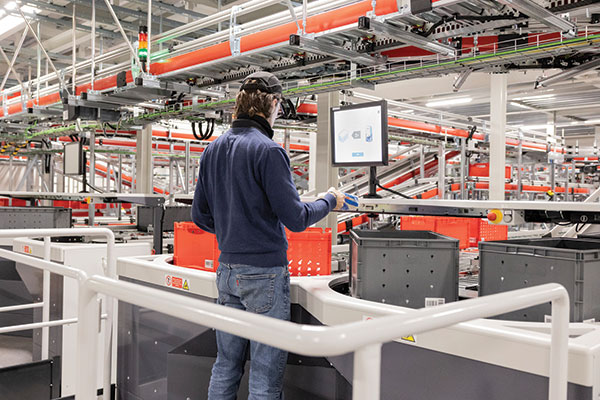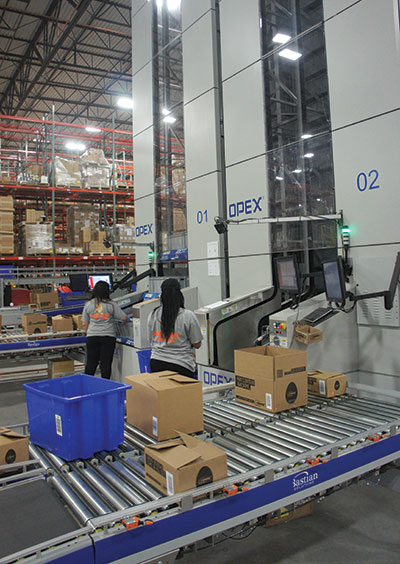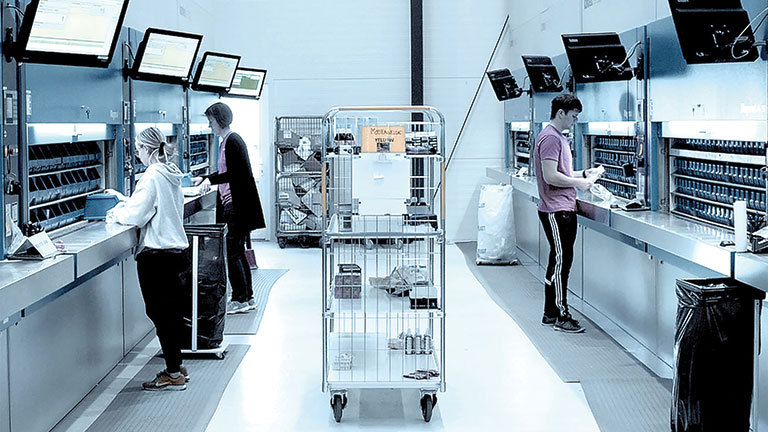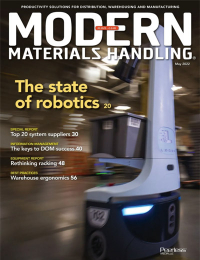Automated storage gets a makeover
High-density, high-efficiency storage is a given these days with automated storage from unit load systems to case and part handling systems. Now the focus is on making automated storage an even stronger player in order fulfillment.

This started as a simple story about automated storage. Except it isn’t about storage. Instead, it’s actually a story about high-performance order fulfillment using automated storage systems. Let me explain how that happened and why you should care.
To begin, there has never been a broader range of options for automated storage of everything from full pallet loads to cases and even individual parts in totes. Solutions include traditional unit load systems as well as automated storage and retrieval shuttle systems (AS/RS), cube AS/RS, vertical lift modules and robotic AS/RS (see box, page 72).
By the way, Markus Schmidt, president of Swisslog Americas, says the term AS/RS is falling out of favor. He prefers the phrase automated inventory engines. “Order fulfillment with these systems is all about flexible, fast, agile robotics.” And he’s right.
Quite simply, unit loads have been joined by systems that use various forms of robots to manage cases and totes. Each, in their own way, takes the original model of a unit load and makes that concept more versatile and able.
As different as the hardware is, they are all goods-to-person systems. They all rely heavily on software and integration to get the job done. All of which is more than just good, it’s GREAT. Order fulfillment needs all the help it can get these days.
At this point, these units are all well established and deliver efficient, high-density storage and order fulfillment. This didn’t happen overnight, and the installed base is substantial. For instance, AutoStore’s cube AS/RS alone has more than 800 installs, explains David Clear, the company’s vice president of business development for North America.

And surely, someone somewhere will someday come up with a way to improve on the storage aspect of this hardware. But until then, suppliers can concentrate on how these systems do more than just store stuff.
Now is a great time to develop their capabilities to fulfill orders rapidly without compromising accuracy in a highly dynamic consumer-based marketplace. Sounds like a strong challenge, and it is. But recent developments across the board in automated storage demonstrate how this envelope can be expanded. And it’s timing couldn’t be better.
“Consumers today insist on extensive variety,” notes Tom Swovick, market development manager for food and beverage at Dematic. “And that desire for many choices requires automated systems to maximize selectivity in the order picking process. Automated storage systems are built around those needs,” he adds.
It’s also worth noting that unit load remains an important component of automated storage. In fact, shuttle systems are a highly visible part of many leading unit load systems. So don’t sell them short, but do know they’re no longer the epicenter of automated storage. Here’s why.
Priorities
Consumer variety is not the only influencer here. Companies need to better manage their processes for case and piece pick. Quite frankly, we no longer live in a unit load centric world.
The labor shortage is just a given by now, cutting a clear path for automation where it may not have been considered a short time ago. If an activity is performed more than 15 times in an eight-hour shift then it’s a candidate for automation, says Nathan Wolf, vice president of sales for TGW.
Distribution companies also want to get the most storage per square foot, explains Monty McVaugh, manager of the product management group at OPEX. He says that today’s construction costs of $12 to $19 a square foot place a high value on high-density storage systems. Fortunately, automated systems do just that, regardless of technology. “Whichever system has the lowest cost per storage location is the winner in system selection,” says McVaugh.

Dan Labell, owner of Westfalia Technologies, echoes the importance of cost per location in manufacturing, too. But the range there is wide. Labell says cost per location can be as high as $3,000 to as low as $400. The trick, he says, is to design the automated storage system using key data from order lines per year to actual orders. By the way, designing the right system for distribution follows the same discipline.
The intelligence of these systems is also critical, explains Douglas Card, director of systems and integrator sales at Kardex Remstar. Automated storage systems require extensive software to manage even the simplest process. Quite simply, they need to be integrated with other order picking systems in a distribution center to ensure efficient order fulfillment. The result, says Card, is that these systems need to put an emphasis on being scalable, dynamic and highly flexible. And they do.
There’s also the matter of getting as close to the customer as possible. In a world that really likes the idea of same-day delivery, fulfillment centers are rapidly moving from giant footprints at a distance from the ultimate customer to smaller footprints in a city or even at the back of a store.
As Schmidt of Swisslog Americas explains, micro-fulfillment center (MFC) systems must be “super-time sensitive, highly coordinated and able to fill orders on a precise schedule.” In addition, inventory must be “hyper-available.” Put that in a grocery store, and Card’s comments about the value of integration become exponentially apparent.
Right now, grocery is the sweet spot for micro-fulfillment, says Schmidt. “Lots of people talk about non-grocery micro-fulfillment centers, but for now that’s mostly just talk.” Schmidt notes.
If the general trend of e-commerce has changed automated storage of late, these micro-fulfillment centers in the back of your grocery store and beyond are a driver of the future of automated storage, says Dematic’s Swovick. In fact, he goes so far as to say micro-fulfillment is actually an entirely new retail channel that will extensively affect distribution going forward. And automated storage clearly has the inside track here.
Automated Storage terms to know
- Cube AS/RS: A horizontal matrix of side-by-side bin locations that store inventory with essentially no space between bins. Robots on wheels run on the top of the matrix to drop bins into selected locations and retrieve them for order fulfillment. The technology is from AutoStore with all installations done by Swisslog (300 installs worldwide), Dematic and other system integrators.
- Robotic AS/RS: This enclosed storage system uses multiple robots running in a center aisle to access storage locations on both sides of the aisle. The robots bring their loads to an-end-of-aisle window for dropoff and pickup of other items for storage. The technology is from OPEX.
- Shuttle AS/RS: Like traditional AS/RS, a center storage/retrieval (S/R) machine accesses storage lanes on both sides of a center aisle. As the S/R machine moves in the aisle to a front location, shuttles retrieve and put away cases and totes in individual storage lanes, bringing their loads to the S/R machine. Suppliers include Dematic, Swisslog, Westfalia and TGW.
- Unit-load AS/RS: This is the traditional automated storage and retrieval system. It handles unit loads that are moved by a storage/retrieval machine that runs in a center aisle with storage locations on both sides. Pickup and deposit of loads is one end of the aisle. Suppliers include Dematic, Swisslog, Westfalia and TGW.
- Vertical lift module: A vertical storage system that has a small storage/retrieval machine in a center aisle that services storage locations on either side. Items are retrieved and delivered to a front window for picking. Kardex Remstar is a supplier.
- Cube AS/RS: A horizontal matrix of side-by-side bin locations that store inventory with essentially no space between bins. Robots on wheels run on the top of the matrix to drop bins into selected locations and retrieve them for order fulfillment. The technology is from AutoStore with all installations done by Swisslog (300 installs worldwide), Dematic and other system integrators.
- Robotic AS/RS: This enclosed storage system uses multiple robots running in a center aisle to access storage locations on both sides of the aisle. The robots bring their loads to an-end-of-aisle window for dropoff and pickup of other items for storage. The technology is from OPEX.
- Shuttle AS/RS: Like traditional AS/RS, a center storage/retrieval (S/R) machine accesses storage lanes on both sides of a center aisle. As the S/R machine moves in the aisle to a front location, shuttles retrieve and put away cases and totes in individual storage lanes, bringing their loads to the S/R machine. Suppliers include Dematic, Swisslog, Westfalia and TGW.
- Unit-load AS/RS: This is the traditional automated storage and retrieval system. It handles unit loads that are moved by a storage/retrieval machine that runs in a center aisle with storage locations on both sides. Pickup and deposit of loads is one end of the aisle. Suppliers include Dematic, Swisslog, Westfalia and TGW.
- Vertical lift module: A vertical storage system that has a small storage/retrieval machine in a center aisle that services storage locations on either side. Items are retrieved and delivered to a front window for picking. Kardex Remstar is a supplier.
What’s newest
After talking to suppliers, there is no lack of ideas to improve order fulfillment with these systems.
Ask McVaugh and he points to a new OPEX goods-to-person system called Infinity, which is the next-generation evolution of the company’s Perfect Pick robotic AS/RS. The platform tailors to infinite configurability of totes and tote cell dividers as needed to accommodate a highly dynamic product mix and storage density. It also uses proprietary software to adapt storage schemes and work processes to the conditions at hand.
New workflows also figure prominently in what’s new from Kardex Remstar, says Card. The Kardex Color Coding System uses lights in primary colors to guide multiple order pickers filling orders in multiple zones for maximum throughput. The idea is to keep up with dynamic order fulfillment that otherwise offers extensive opportunity for orders, batches and pickers to get in the way of each other.

Over at AutoStore, Clear talks about a new Bin Lift 2.0. It extends the AutoStore grid for even more efficient space utilization, connecting grids on multiple floors or allowing for order picking to take place on a different floor in a multi-level warehouse. The company has also introduced the R5+, a new robot capable of handling larger bins, up to 425 mm, without sacrificing throughput.
These new upgrades build on the company’s launch of the Router software in 2020. The software allows for more efficient traffic management in the system as a whole and has opened the door for dense grids for MFC applications, as well as extremely large systems with hundreds of thousands of bins.
Meanwhile, Schmidt at Swisslog is focused on a next generation breakpack order fulfillment concept. Software driven, the system goes beyond the established approach of one robot picking to one tote. Instead, a single robot picks to as many as 52 totes.
Totes are then routed to a shuttle system for order buffering before they are called out in the exact sequence for shipping. To support that, Swisslog Americas has signed an agreement to partner with piece-picking robot supplier Berkshire Grey.
Along those lines, Labell of Westfalia mentions his early-stage development of layer pick and replenishment technology for unit load systems used in manufacturing. Still in R&D, the system promises, he says, to simplify case picking yet extend selectivity for kitting in particular.
There’s little doubt that automated storage has moved on from its original king—unit load storage. But if you want a glimpse into just how much automated storage is changing, listen to Swovick describe an 11-story tall, tote-handling system in a vertical farm that grows food-grade insect protein. Otherwise known as crickets. No matter how you cut it, that’s a long way from a 2,000-pound unit load.

Article Topics
Automated Storage News & Resources
Coles automates grocery distribution in Australia TGW Logistics and OPEX Corporation form a strategic partnership HWArobotics delivers advanced AS/RS technology to e-commerce specialist Darwynn Kardex FulfillX for AutoStore can help businesses meet goals in under 6 months The Stow Group puts the spotlight on its Movu Robotics brand Ocado Intelligent Automation expands industries with end-to-end fulfillment technology Exotec displays AS/RS More Automated StorageLatest in Materials Handling
Geek+ and System Teknik deploy PopPick solution for pharmacy group Med24.dk Beckhoff USA opens new office in Austin, Texas Manhattan Associates selects TeamViewer as partner for warehouse vision picking ASME Foundation wins grant for technical workforce development The (Not So) Secret Weapons: How Key Cabinets and Asset Management Lockers Are Changing Supply Chain Operations MODEX C-Suite Interview with Harold Vanasse: The perfect blend of automation and sustainability Consultant and industry leader John M. Hill passes on at age 86 More Materials HandlingAbout the Author
Subscribe to Materials Handling Magazine

Find out what the world's most innovative companies are doing to improve productivity in their plants and distribution centers.
Start your FREE subscription today.
April 2024 Modern Materials Handling

Latest Resources











